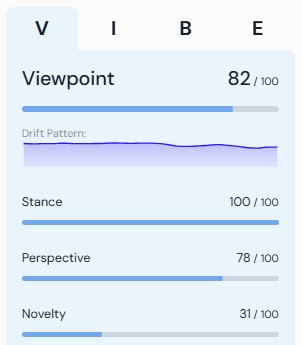editor
Penfriend.ai VIBE score
What is it? Why did we make it? How to get the most out of it.

What is the Penfriend.ai VIBE score?
The VIBE score is a number XX/100 to tell you how readable your content it.
Readable? Well, it turns out there have been many research papers into what makes people read and take notice of long-form written content.
We took 212 of those papers, worked out the common points across them all and turned it into a score.
A score broken down into 4 section.
V- Viewpoint
I - Individuality
B - Beat
E - Evidence
Then we took +300 of the internets most praised blogs and tuned the model to score for why they are loved so much.
The VIBE score enables you to see what you need to do to make content that reads well, carries a point and ultimately, set you apart from your competitors and any AI slop.
Why did we make the VIBE score?
A combination of a few things.
The main one is to help you, and me, write better.
The VIBE score helps you to see exactly where you can improve your writing.
It enables us to build an in-editor feedback system to highlight those exact issues, and give suggestions on how you can address them.
And finally, with all the "AI detection" sites out there, we wanted to make a "well-written detection". As it happens we can do that, and make it data baked.
It's pretty cool to have a score that tells you your content is strong in your opinion, but lacking the perspective to show you understand it's shortcomings. And then tell you how to address it.
What are the different letters for?
The letters are the four major checks we make to understand your content.
Yes, its the VIBE check....
V - Viewpoint
From all the research we did in building the VIBE score, the most commonly researched characteristic on what makes for great writing is your viewpoint.
It turns out that it's a very human thing to have. An opinion.
Now, how you express that opinion, and all it's subtleties are taken into account with the V score.
Click here to understand the components we used to build the V score.
I - Individuality
The second most important factor is does it feel like the author actually did what they are advocating for in the article. Are their stories? Is there first person language (I, we, they). How did the person feel? What were the risks?
It's all about, can you tell a person is behind this?
Click here to understand the components we used to build the I score.
B - Beat
Now, we first experience content by skimming.
You earn the long read, by winning the short read.
B is all about your presentation. Are your sentences fun to read? Do they have a certain musicality to them? Are you using headings, and images, and quotes to showcase the writing?
Click here to understand the components we used to build the B score.
E - Evidence
And finally. Can you prove you even did the thing?
How trustworthy are your words?
From external sites you link to to the strength of your advice.
Click here to understand the components we used to build the E score.
What are the components?
The components are the sub-checks we have for each of the letter scores.
There are 27 in total. Click on any of the checks above to understand the components and how they work to build the end VIBE score.
Under each of the components, if you're on the Pro or Max plans you'll see a "drift pattern". This shows you how that component scores and changes over the course of the whole article.

What are the archetypes?
Once we had all the component working, and the individual weights of all the checks we started to run some of the internets favourite articles through the model.
Think Medium best articles. New Yorker. Fast Company. If it exists on the internet as long form, and has a lot of shares, links, comments, we put it through the system.
One to tune the system and get the scoring in place.
Two, to spot patterns.
Do all thought leadership articles have a component pattern?
Is there a reason all the how-to articles and guides in our list do well, whilst others flop?
Turns out yes.
Certain article types have a component pattern. At the time of writing we have 18 patterns identified.
We call them Archetypes.
How do we use those patterns?
Well, it would be unfair for us to judge the guide you just wrote against the pattern for an interview.
So, we see how close you are to filling a specific pattern, and we score against that.
How do I score against a specific archetype?
Our next update will have this inside the editor.
For now, check out the archetypes page, and find the archetype that matches the blog type you're going for. And see what components define that archetype.
You can then, in the feedback on the left, find the feedback that covers those components and you make the suggested changes.



